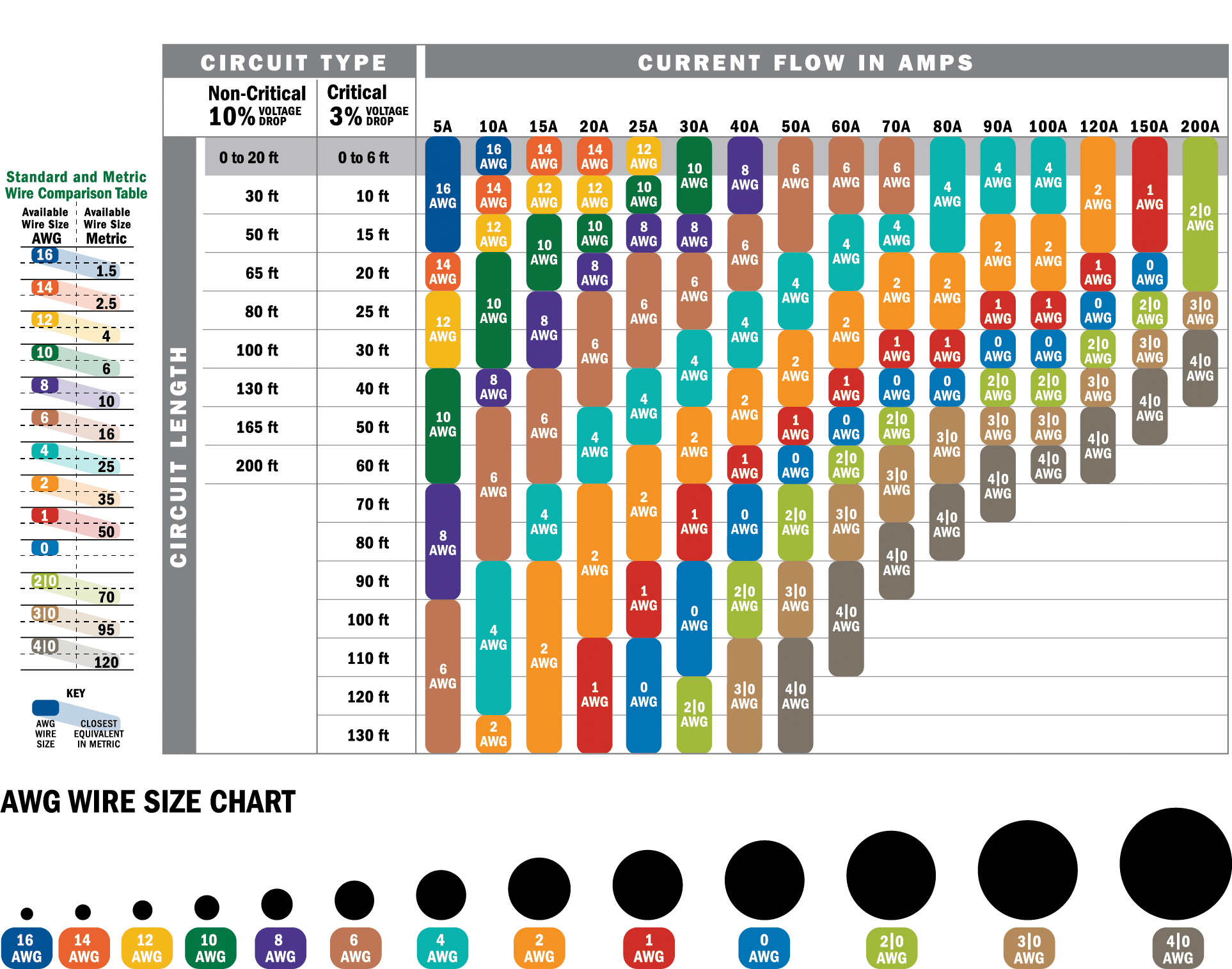Correct wiring is important to avoid problems.
But which cable should you use where?
The wire to be used is one that can withstand the total current that flows through it.
In addition, we always need twice the distance of the cable for the calculation.
Twice because the first section of the cable goes to the consumer and the second section leads away from the consumer.
How do I calculate the correct cable?
In principle, this is easy.
The first, and perhaps most important, the relationship between current, voltage, and resistance is called:
Ohm’s Law.
An electric circuit is formed when a conductive path is created to allow electric charge to continuously move. This continuous movement of electric charge through the conductors of a circuit is called a current.
The force motivating charge carriers to “flow” in a circuit is called voltage. Voltage is a specific measure of potential energy that is always relative between two points.
Current tends to move through the conductors with some degree of friction, or opposition to motion. This opposition to motion is more properly called resistance. The amount of current in a circuit depends on the amount of voltage and the amount of resistance in the circuit to oppose current flow. Just like voltage, resistance is a quantity relative between two points.
Units of Measurement: Volt, Amp, and Ohm
To be able to make meaningful statements about these quantities in circuits, we need to be able to describe their quantities in the same way that we might quantify mass, temperature, volume, length, or any other kind of physical quantity.
This are the standard units of measurement for electrical current, voltage, and resistance:
| Quantity | Symbol | Unit of Measurement | Unit Abbrevation |
| Current | I | Ampere (Amp) | A |
| Voltage | V | Volt | V |
| Resistance | R | Ohm | Ω |
To find the Voltage, ( V )
[ V = I x R ] V (volts) = I (amps) x R (Ω)
To find the Current, ( I )
[ I = V ÷ R ] I (amps) = V (volts) ÷ R (Ω)
To find the Resistance, ( R )
[ R = V ÷ I ] R (Ω) = V (volts) ÷ I (amps)
But what we need is to find the electrical power within the circuit.
Electrical Power, ( P ) in a circuit is the rate at which energy is absorbed or produced within a circuit. A source of energy such as a voltage will produce or deliver power while the connected load absorbs it.
The quantity symbol for power is P and is the product of voltage multiplied by the current with the unit of measurement being the Watt ( W ).
To find the Power (P)
[ P = V x I ] P (watts) = V (volts) x I (amps)
Practical use and example:
It sounds very theoretical and a lot right away. But in practice it is very easy to implement.
As an an example:
Our R2-D2 is powered by a 24V battery and we use foot motors that require (maximum) 150W.
We know:
[ P = V x I ] P (watts) = V (volts) x I (amps)
so:
[ 150W = 24V x I ]
Just divide the 150W with 24V
[ I = 150W / 24V ] = 6.25A
Now we know we need a wire that can safely transport 6.25A from the battery to the motor.
If you’d use a 12V Battery what would happen?
Correct… the Ampere would double because the voltage is cut in half.
[ I = 150W / 12V ] = 12.5A
Now we need to know the lenght of the wire.
The other factor for wiresize calculation is the lenght of the wire.
If the wire from Battery to Motor is 8 feet (~2,44m) you need a wire than will carry the 6.25A for a lenght of 16 feet (~4.90m). And always round up vor Ampere and Lenght.
AWG Chart
The good thing is, there are many wiregauge charts out there. And the wire unit we’re looking for is the AWG (American wire gauge).
AWG defines the wire we need.

And even better, we won’t need most of this because there won’t be a wire running 600A for a lenght of 100 feet (~30.5m).
We can break it down to wires that can run up to 45A over 25 feet (~7.6m). So we can almost ignore the lenght of the wire and focus on the flowing amps.
That makes the list much smaller and you’ll only need 4-5 different wire sizes.
What wires we really need:
A Servo Wire has normal AWG 23 that means it can handle ~4A
So as those is mostly the thinnest wire we use we can start the list at AWG 23 and end the list at AWG 10 (45A) Because even with 150W motors running at max in a 12V system need only 16.6A.
So for the main power wires we have enough reserve.
And to even make it more simple we just use always the next bigger size if in doubt and the wires we will use are:
AWG 10
AWG 12
AWG 14
AWG 16
AWG 18
AWG 20
| AWG | Diameters in Inches | Diameters in Millimeters | max A |
| 10 | 0.125 | 3.25 | 45 A |
| 12 | 0.104 | 2.64 | 35 A |
| 14 | 0.08 | 2.03 | 25 A |
| 16 | 0.064 | 1.63 | 20 A |
| 18 | 0.048 | 1.22 | 15 A |
| 20 | 0.036 | 0.91 | 10A |
We even could use even thinner wires but AWG 20 is pretty small for a big Droid like R2-D2
